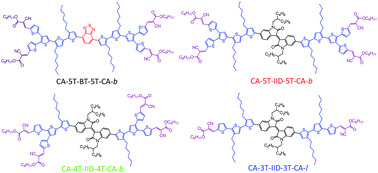To establish a correlation between the molecular structure, physicochemical properties, thin film morphology, charge carrier mobility and photovoltaic performance of isoindigo-based electron donor type molecular semiconductors, a series of branched and linear A2–D–A1–D–A2 small molecules (A = acceptor, D = donor) are synthesized. The extended π-conjugated molecular chromophores have an electron-accepting isoindigo core, a bridging oligothiophene electron donor part and terminal octyl cyanoacrylate acceptor moieties. Their photophysical, thermal and electrochemical properties are analysed and the materials are applied in organic field-effect transistors and bulk heterojunction organic solar cells. Compared to an analogous benzothiadiazole-based small molecule, the isoindigo core deepens the HOMO energy level, enabling higher open-circuit voltages in organic solar cells. The linear isoindigo-based small molecule shows an enhanced hole mobility compared to the branched derivatives. The best power conversion efficiency of the investigated set is also obtained for the solar cell based on the linear (CA-3T-IID-3T-CA-l) donor molecule in combination with PC71BM.

